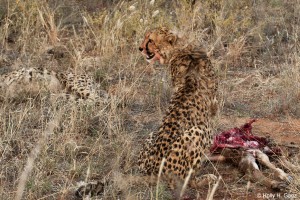When we talk about animals in the built environment, we tend to mostly think about our companion animals such as dogs and cats. Of course insects and rodents also live alongside us. And many other animals live in built environments, including farms, zoos and aquariums. I study the microbes associated with cheetahs. In captivity cheetahs exhibit a number of health disorders, many of which probably arise from what they are fed. In the wild, cheetahs eat whole carcasses but it is not always practical to provide carcasses to captive animals. Consequently they are often fed too many carbohydrates and not enough fats and salts (animals that eat carcasses are a bit like vampires in that they need to drink blood). All of this affects their health and probably also their microbiome.

In addition to dietary concerns, cheetahs in captivity become infested with cheetah flies. In the wild, cheetah move around too much for their habitat to become infested but it is a big problem for them in captivity. Cheetah flies are blood sucking, cause anemia and can carry disease. Flies were also a problem for human settlements and reflects the consequences of living at increased population density and adopting a sedentary lifestyle. Here is a video of some cheetah flies. Fortunately Frontline is an effective treatment.